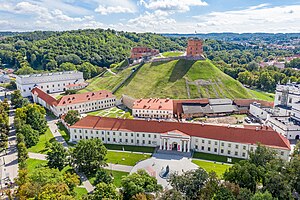| Vilnius Castle Complex | |
|---|---|
| Lithuania | |
 Vilnius Castle Complex | |
| Site information | |
| Controlled by | Lithuania, Russia, Sweden |
| Site history | |
| Built | Parts of castle in 10th century |
| In use | For defense from 10th-17th centuries |
| Materials | Stone, bricks, wood |
| Official name | Vilnius Old Town |
| Type | Cultural |
| Criteria | Cultural: (ii), (iv) |
| Designated | 1994 |
| Reference no. | 541 |
| UNESCO region | Europe |

Upper Castle: 1. Western tower (Gediminas Tower); 2. Southern tower (foundations remain); 3. Castle Keep (ruins remain)
Lower Castle: 4. Gates and bridge to the city (Pilies Street); 5. Road and bridge to Tiltas Street; 6. Vilnius Cathedral; 7. Palace of Supreme Tribunal; 8. Palace of bishops; 9. Royal Palace; 10. Palace garden; 11. The New Arsenal, currently a museum; 12. Northeastern tower and gates of the Old Arsenal; 13. Yard of Old Arsenal
The Vilnius Castle Complex (Lithuanian: Vilniaus pilių kompleksas or Vilniaus pilys) is a group of cultural, and historic structures on the left bank of the Neris River, near its confluence with the Vilnia River, in Vilnius, Lithuania. The buildings, which evolved between the 10th and 18th centuries, were one of Lithuania's major defensive structures.[1]
The complex consisted of three castles: the Upper, the Lower, and the Crooked (Lithuanian: Kreivoji pilis). The Crooked Castle was burned down by the Teutonic Knights in 1390 and was never rebuilt.[2] The Vilnius Castles were attacked several times by the Teutonic Order after 1390, but they did not succeed in taking the entire complex. Its complete capture occurred for the first time during the 1655 Battle of Vilnius.[3] Soon afterwards, the severely damaged castles lost their importance, and many buildings were abandoned. During the Tsarist annexation,[4][5] several historic buildings were demolished; many more were damaged during the fortress construction in the 19th century.[citation needed]
Today, the remaining Gediminas Tower is a major symbol of the city of Vilnius and of the nation itself.[6][7] Annually, on 1 January, the Lithuanian tricolor is hoisted on Gediminas Tower to commemorate Flag Day. The complex is part of the National Museum of Lithuania, one of the largest museums in the country.[8]
- ^ Cite error: The named reference
piliswas invoked but never defined (see the help page). - ^ Cite error: The named reference
Albinaswas invoked but never defined (see the help page). - ^ Cite error: The named reference
Sapokawas invoked but never defined (see the help page). - ^ Cite error: The named reference
vorutawas invoked but never defined (see the help page). - ^ Cite error: The named reference
Language Policy in the Soviet Unionwas invoked but never defined (see the help page). - ^ Cite error: The named reference
dukewas invoked but never defined (see the help page). - ^ Cite error: The named reference
govwas invoked but never defined (see the help page). - ^ "Muziejai" (in Lithuanian). Lietuvos nacionalinis muziejus. 31 October 2019. Retrieved 28 March 2024.